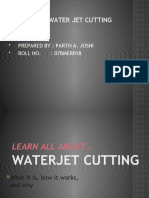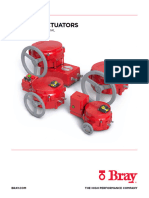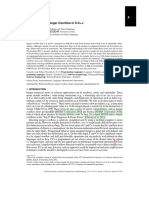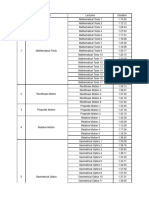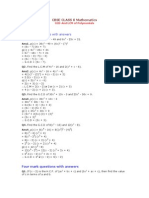SAW D Manual
SAW D Manual
Uploaded by
jlmansillaCopyright:
Available Formats
SAW D Manual
SAW D Manual
Uploaded by
jlmansillaOriginal Description:
Copyright
Available Formats
Share this document
Did you find this document useful?
Is this content inappropriate?
Copyright:
Available Formats
SAW D Manual
SAW D Manual
Uploaded by
jlmansillaCopyright:
Available Formats
HONGBAI
TECHNOLOGY
INDUSTRIAL CO., LTD
OPERATING MANUAL FOR SAW-D/1/I SERIES
DIGITAL CAPACITOR DISCHARGE
STUDWELDING EQUIPMENT
Thanks for choosing HBTech! Please read through this Thanks for choosing HBTech! Please read through this Thanks for choosing HBTech! Please read through this Thanks for choosing HBTech! Please read through this manual before using! manual before using! manual before using! manual before using!
Content Page
1 General Information 1
2 Working Principle and Structure 1
2.1 Principle 1
2.2 Structure 2
2.3 External Features, Symbols, and Functions 4
3 SAW-D Series Technical Data 5
4 Setting Up and Wielding 5
4.1 Cautions 5
4.2 Setting Up 6
4.3 Wielding 6
5 Quality Control 7
5.1 Quality Standard 7
5.2 Personnel Requirement 7
5.3 Test Method 7
5.4 Test in Practice 8
6 Maintenance 8
6.1 Stud Wielding 8
6.2 Replacing Components 9
7 Failure Analysis 9
7.1 Failure Code 9
7.2 Failure Instructions 10
8 Services 11
8.1 Before-Sale Service 11
8.2 After-Sale Service 11
9 SAW-D Series Circuit Schematic 12
10 SAW-D Series Standard Deployment 13
1
1. General Information
Shenzhen HongBai Technology Industrial co., LTD is a company specialized in
researching and manufacturing of stud wielding. The company owns a team of
senior professionals of wielding technology. With over 10 years in studwelding
industry, we have designed and manufactured advanced and finest studwelding
equipments and their automation equipment series, granted by the nation the
torch program certificate-approval number: [2003I98].The company was assessed
and registered against the following quality management standard: ISO9001:
2000 in the year 2004.
SAW-D/1/I series is capacitor discharge stud wielding equipment, it
applies advanced micro processing technology, which can be used to control
wielding time sequence, the amount of electricity released by the capacitor and
monitor the operating condition. SAW-D/1/I series can weld studs directly
on mild steel, stainless steel, aluminum and copper; The largest welding thickness
can be up to 10mm. With the features of easy and convenient handling, steady
welding and barely deforming, they can be widely applied in automobile, aviation,
shipbuilding, metal processing, building decoration, construction, elevator
manufacturing, kitchen equipment, boiler making, sheet metal, height voltage
swith plank, distribution box, heat insulation industry.
2. Working Principle and Structure
2.1 Principle
Monophase 220V mains supply can be transformed into two voltages, one
19V supplies power for the whole machine after rectifying; The other rectified
200V charge the capacitor, the voltage between the two ends of the capacitor can
be controlled and regulated by controlled silicon, range from 25V to 200V.
Controllable silicon phase synchronous controller can be finished by MCU. It can
synchronize the shutdown of controlled silicon with itself; it can also identify the
null point of the AC Mains Supply Voltage accurately. Internal phase shift control
circuit controls and regulates the phase shift, drive the controllable silicon after
being amplified and reshaped, and controls the height of voltage between the two
ends of the storage capacitor through regulating the conduction angle.
The program of MCU controls working sequence, phase shift control quantity,
2
data gathering, monitoring, transferring and protecting functions, etc.
While welding, discharge SCR triggers by conduction, the charges on the
storage capacitor impose between studs and the workpiece through discharge
circuit, produce electric arcs and discharge at the tip with the power stored in the
capacitor, and generate great quantity of heat within a very short time
(0.001~0.003s), forming a 0.5mm molten pool on the surface of the melting metal,
which can bond studs and the workpiece together firmly.
2.2 Structure
SAW-D/1/I series consist four parts. One is CPU board, mainly in charge
of processing the collected signals, displaying, man-machine interaction and
sending orders to the main control board. The second one is main control board,
mainly in charge of amplifying, processing voltages and current analog signals, and
controlling the conduction and shutdown of SCR. The third one is the main circuit
which is an execution unit controlling the charging and discharging of storage
capacitor. The last part is chassis and operation panel, used for man-machine
communication and protection. The operation panel is as shown in the picture.
3
SHENZHEN HONGBAITECHNOLOGY INDUSTRIAL CO., LTD
1
4 5 6 7
8
3 4 5 6 7 8 2 3
8 8 8
70 100 115 140 175 190
9
10 11 12
13
15
220mm
16 17
240mm
Classis size: 440`240`220mm
4
2.3 External Features, Symbols, and Functions
No. Symbol Name Function
1
8 8 8
Digital Tube
Display reserved capacitance charge voltage value
and working status information
2
Increasing
Function Key
Increase the charging voltage of the storage capacitor
3
Decreasing
Function Key
Decrease the charging voltage of the storage capacitor
4
Green
Luminotron
Readiness Indicator. Lit up when the capacitance
value reaches the set point
5
Green
Luminotron
Contact indicator. Lit up when Stud contacts the
workpiece. (Proper ground is required!)
6
Green
Luminotron
Relay released indicator. Lit up when the welding
pistol is triggered, welding starts
7
Red
Luminotron
Malfunction indicator
8
Stud
diameter
Diameter of the studs to be welded
9
8 8 8
Welding
parameter list
The reference setting value of stud diameter and
charging voltage
10
Control line
outlet
Control line of the pistol switch. When the machine is
set, it is ready to switch on and weld
11
Pistol
Terminal
Mark the terminal of pistol wire. Used to connect the
pistol wire
12
Ground
Terminal
Mark the terminal of ground terminal. Used to
connect the ground with the workpiece
13 Power switch Used to turn on and off the welding power
14
Power fuse
holder
For overcurrent protection
15
Power outlet
Welding power cable connection. Used for connecting
single-phase 220V AC power
16 Fan guard Security
17 Nameplate Production description
5
3. SAW-D Series Technical Data
1. Weldable Materials: Low carbon steel, Stainless steel, Aluminum, Copper, etc.
2. Weldable Thickness of the Work Piece: 0.2~10mm
3. Weldable Stud Diameter: D/1Series 2~8mm; DISeries 2~10mm
4. Welding Time: 0.001~0.003s
5. Standard Pistol: SAW--DH
6. Input: 220V AC10% Frequency: 50~60Hz1%Single-phase
Rated Capacity: DSeries 300W; D1/ISeries 350W
7. The Range of Capacitors Charging Voltage: 25V~200V
8. Capacity of Storage Capacitor:
DSeries 66000uF; D1Series 72000uF; DISeries 108000uF
9. Welding Productivity: 15/min
10. With monitoring and protection functions of input and output voltages.
11. Charge over-current protection
12. Weight: DSeries 15kg; D1Series 18kg; DISeries 20kg
13. Required Working Condition:
The ambient air temperature: -10~ +40
The relative temperature of the ambient air: 5" (40); 90" (20)
4. Setting Up and Wielding
4.1 Cautions
The welder must be installed on a horizontal surface. The four rubber feet on
the welder base are nonskid and shock-proof.
Although the welder is able to withstand regular impact, but it still needs to be
taken care of the shock and dust.
Please pay attention to the safety and security of the seat of the welder.
Please ensure that there is enough space around the welder for heat
dissipation.
The welder should be placed near the welding area.
Please ensure the right connection to the electricity.
Too long the cable will lead to a voltage drop, so please choose a proper length.
Please ensure the air circulation of the factory building.
The fuse specifications for SAW-DI: General supply insurance an F (12A).
The fuse specifications for SAW-DIs internal circuit boards: Charging
insurance F1 (6.3A); Control insurance F2 (2A); Fan insurance F3 (0.25A).
6
Warning: The insurance can only be replaced with the ones which has
corresponding electrical parameters. The insurance that exceed the
specifications would lead to fatal danger caused by fire or electrical failures.
Power must be cut off before replacing the insurance.
4.2 Setting Up
Connecting one end of the ground wire to the ground interface, the other end
to the proper position on the workpiece.
Connecting the pistol connection to the pistol interface on the welding
machine, and rotate it clockwise until it is locked.
Plugging the control cable into the control cable interface on the welder, and
tighten the lock screw.
Plug one end of the power cord into the power outlet on the welder, and the
other into the AC 220V power.
Note: All connections must be tightened.
4.3 Wielding
Switch on the welder, the 4 LED indicators on the front panel briefly shinning
on boot-up; the welder should be restart when E-2 error message displayed on
the LED display. If it still shows error, then troubleshooting has to be done.
Settings of the Welder: The parameters of the stud welding machines vary
depending on the pistol types and welding materials, they should be set
according to the actual situations. While under normal situations, they could
be set according to the parameters on the front panel.
Type 1 11 1 parameters:
3 4 5 6 7 8
8 8 8
70V 100V 115V 140V 175V 190V
Type 1 11 11 11 1 parameters:
2 3 4 5 6 7 8
8 8 8
40V 65V 95V 110V 130V 160V 180V
Type 1 11 1I II I parameters:
2 3 4 5 6 7 8 10
8 8 8
40V 60V 90V 105V 125V 155V 170V 190 V
Note: The parameters above are for aluminum studs
welding, only for reference; the parameters can be reduced
while welding iron or stainless iron studs.
7
The actual charging voltage varies depending on different stud diameters.
The contact indicator would light up when placing the welding pistol equipped
with studs on the surface of the workpiece.
Pulling the switch of the pistol, and then the release relay indicator is lit, the
welding process begins.
Note: To ensure a normal welding process, the switch of the pistol needs to be
pulled quickly. In the whole welding process, the pistol needs to be
perpendicular to the workpiece surface, and it should be moved away from the
surface after the welding. Sometimes there might be operations mistakes such
as slip when welding, these can be detected by the welder and the fault
indicator lit up. In this case the welder needs to be restarted.
Shutting down the welder: Turn off the power switch behind the welder,
disconnect the mains, welding, control and ground cables.
5. Quality Control
5.1 Quality Standard
Peoples Republic of China Machinery Industry StandardJB/T8323-1996`
Stud Welder.
The standards of the Shenzhen Hongbai Technology Industrial Co., LtdAuto
body and coated steel planting studs series equipment`
5.2 Personnel Requirement
Qualified and Responsible.
The operators can operate and manage the welders only after they have the
appropriate training and get the corresponding qualifications.
The connection and maintenance works can only be done by personnel who
have received electrical training.
5.3 Test Method
To guarantee that the correct use of the stud welder system and the right
choice of welding materials, the strength of the welding surface should
always be bigger than that of the studs. Additionally, there should also be the
following tests in the general production practice:
The standard test: Typically, the standard work test must be taken repeatedly
before the actual welding practice, and the test should be under the
supervision of the user. The number of the welding tests could be decided by
the engineer in charge based on the actual situation. The standard test may be
affected by the stud diameter, the material of the workpiece and the device
8
type. The test includes visual inspection (all samples), tensile testing (at least 3)
and the bending test (at least 3).
Simple test: Used to test welding settings and features. This test should be
taken after some time of continuous welding. It includes visual inspection (all
samples) and the bending test (all samples).
5.4 Test in Practice
Test samples: the studs to be used for the test are welded on a base metal, size
less than 700*200mm. The welding position and the distance from the edge
should all be the same.
Visual inspection: used for a cursory examination for the main problem, for
estimating the identity of the weldment. In case of uncertainty, tensile testing
and torsion testing are highly recommended.
Tensile testing: tensile testing is aimed at testing the bond strength between
the stud and base metal. The minimum testing stud number is three. Add an
increasing axial tension on the stud until the fracture occurs. If the user prefers
to process a stud pull test in a certain percentage, special stress meter devices
are required. If the fracture occurs outside the weld zone, then it is a successful
welding. If it happens in the zone, then an extra test about the fracture is
needed. The unwelded area should not exceed 20% of the total welding area.
When there are questions, please contact the company or the regional office. If
the number of the failed welding studs exceed the specific standard value, then
the reason of the failure must be found, the parameters must be corrected, and
a re-test is needed.
Bending test: Used to cursory examine the chosen parameters. Using a specific
tube to bend the stud (at least 3 studs in the test) 30 degrees, if there is no
crack or fracture, the welding is successful. If not, and the number exceeds the
standard value above, then the reason and a re-test is necessary.
6. Maintenance
6.1 Stud Wielding
Based on the structure of the stud welder, its outside does not need to be
cleaned very often; however, the inside needs to be cleaned regularly according to
the exterior environment.
9
6.2 Replacing Components
Damaged components must be replaced by service or trained and
authorized personnel. And the quality of the welder can only be
guaranteed by using the original accessories.
7. Failure Analysis
7.1 Failure Code
When there is a fault, the fault code appears in the digital display.
Fault code Description Reason
C-1 Supply voltage fault Too large the voltage deviation
C-2 Exceed discharging duration
Discharging circuit hardware
failure
C-3 Exceed charging duration
Charging circuit hardware
failure
C-4
Transformer
over-temperature
Exceed the welding period
C-9
Too large the difference
between the actual value and
set value
Charging or discharging circuit
failure
Safety Warning
The power supply must be cut off before opening the chassis. Only
trained and qualified technicians are allowed to open the chassis and
replace the electrical components. Contact the company or regional
office when necessary.
Safety Warning
Please make sure that the capacitors have discharged completely
before the replacement of the components.
10
7.2 Failure Instructions
Fault Reason Solution
No
welding,
no dis-
charging
Doesnt boot up Boot up, the ready indicator is lit
Welding, control cable is not
connected or damage, the
ground is not connected with
the workpiece
Check the connection and damage,
replace the components when
necessary.
There is no metal media
detected at the contact point
of the pistol and ground with
the workpiece
Amending the workpiece or stud
The switch
is on, but it
does not
work
Power supply failure Check the power supply insurance
Welder insurance damage Replace the insurance
Error message Restart
The welder
is ready,
but there is
no welding
arc
There is no tip on the top of
the stud
Use the stud with tip or decrease
the center area
Problem with the control
segment
Contact the service personnel of the
company
Stubs loosely contact with
the current contact nozzle
Press or hoop tight the current
contact nozzle
Thread
burned
The current contact nozzle is
too old
Replace the current contact nozzle
The welding voltage is set too
large
Adjust the welding voltage
The
welding
effect is
instable
Cable connector is not
tightened
Tighten the cable connector, clamp
the ground cable
Stud not clamped
Clamp the stud, replace the current
contact nozzle when necessary
The stud does not get into
the contact nozzle completely
Help the stud get into the current
contact nozzle completely
Magnetic blow, the arc
deviates to a direction
Change the position of the earth
clamp, add metal pieces on the edge
of the workpiece and turn the pistol
11
8. Services
8.1 Before-Sale Service
Provide technical advices to the customers about machine selection and
function deployment proactively; Specialize design and manufacturing in order
to meet the special need of different users.
8.2 After-Sale Service
Our promises: One year warranty and lifetime maintenance.
The professional technician will come up with a solution within one day after the
customers call for repairment. For the breakdown that cannot be repaired by the
customer, please send the machine back to the company for repairing. For the
machine that is still under warranty, we will repair it free of charge, and pay
one-way freight; for the machine outside the warranty period, we only charge the
cost of materials, the round-trip transportation costs should be borne by the
customer.
12
9. SAW-D Series Circuit Schematic
13
10. SAW-D /1 11 1/I II I series standard deployment
NO Name Specifications/Model Number Remarks
1 Host power supply SAW-D 1
Configure based
on model
2 Pistol SAW-DH 1
3 Pistol ground wire SAW-D 2
4
Current contact
nozzle
M3, 4, 5, 6, 8 5
5
Current contact
nozzle lock wrench
SAW-D 1
6
Cable connector lock
wrench
SAW-D 1
7 Instructions SAW-D 1
8 Warranty card SAW-D 1
9 Certificate SAW-D 1
Note: Type DI II I has an extra M10Current contact nozzle
14
SHENZHEN HONGBAI TECHNOLOGY INDUSTRIAL CO., LTD
Address: 5/F, Huolibao BLDG, 5#Rd., Northern Section, Shenzhen
High-tech Industrial Park, Shenzhen, Guangdong, China
Tel: 0755-26013288/26013326/26983368
Fax: 0755-26013188
http://www.sawchina.cn
E-mail: saw@china.com
You might also like
- Dieffenbacher Katalog 150 Dpi 2015-04-23Document120 pagesDieffenbacher Katalog 150 Dpi 2015-04-23krilinX0No ratings yet
- Bending Tube E-TurnDocument1 pageBending Tube E-TurnCarlos JuniorNo ratings yet
- OrCAD Capture and Layout Tutorial ExcellentDocument55 pagesOrCAD Capture and Layout Tutorial Excellentbalajiiece100% (1)
- Procedure For Piping Stres Analysis Offshore)Document26 pagesProcedure For Piping Stres Analysis Offshore)ayounga80% (5)
- Problem Set AC CircuitsDocument2 pagesProblem Set AC CircuitsFinn100% (1)
- Water Jet CutterDocument16 pagesWater Jet CutterRex Delon50% (2)
- SPECS Diamond Wire Cutting Machine TYROLITDocument2 pagesSPECS Diamond Wire Cutting Machine TYROLITKhyle Laurenz DuroNo ratings yet
- SAW - Tractor 1000Document2 pagesSAW - Tractor 1000Rizaldi Akhmad SungkawaNo ratings yet
- PLC S7-200Document98 pagesPLC S7-200HoangHiepNo ratings yet
- Mach3 and ModbusV1Document23 pagesMach3 and ModbusV1Enrique ModaiNo ratings yet
- Diamond Wire Saw Machine - 副本 (350591)Document2 pagesDiamond Wire Saw Machine - 副本 (350591)rohit10mpuatNo ratings yet
- FCC WT Docket No. 08-165: Declaratory Ruling (11-18-2009)Document42 pagesFCC WT Docket No. 08-165: Declaratory Ruling (11-18-2009)Federal Communications CommissionNo ratings yet
- MultiCam 3000-Series CNC WaterjetDocument12 pagesMultiCam 3000-Series CNC WaterjetDaniel AustinNo ratings yet
- Chapter 9 Design For Sheet Metal1Document92 pagesChapter 9 Design For Sheet Metal1VishalNaranjeNo ratings yet
- Abrasive Water Jet Machining (AWJM) : Sanjeev Sharma Professor, Deptt. of Mech. Engg. CEC, LandranDocument33 pagesAbrasive Water Jet Machining (AWJM) : Sanjeev Sharma Professor, Deptt. of Mech. Engg. CEC, LandranAbhishek KumarNo ratings yet
- Eurotech 735 Lathes SeriesDocument7 pagesEurotech 735 Lathes SeriesCNC SYSTEMSNo ratings yet
- Eurotech B700 SeriesDocument4 pagesEurotech B700 SeriesCNC SYSTEMSNo ratings yet
- MILL Series GB-1007 01Document20 pagesMILL Series GB-1007 01Ady IonutNo ratings yet
- Gear Pumps: Product RangeDocument4 pagesGear Pumps: Product RangeEng-Mohammed SalemNo ratings yet
- Simufact Sheet Metal Forming 2015Document8 pagesSimufact Sheet Metal Forming 2015MrLanternNo ratings yet
- Water Jet CuttingDocument3 pagesWater Jet Cuttingnatrajan-ram-379No ratings yet
- Introduction To Ansys AutodynDocument16 pagesIntroduction To Ansys AutodynNeetu JhaNo ratings yet
- PCB Design& Simulation LabDocument8 pagesPCB Design& Simulation LabVikram RaoNo ratings yet
- Edm Wire Cut LabDocument6 pagesEdm Wire Cut LabJieMan BahRom100% (1)
- 6040 Usb Software InstallDocument7 pages6040 Usb Software InstallArchil GogorishviliNo ratings yet
- ANSYS Explicit Dynamics 120 Workshop 02Document37 pagesANSYS Explicit Dynamics 120 Workshop 02Love SemsemNo ratings yet
- Abrasive Jet MachiningDocument37 pagesAbrasive Jet MachiningPola Vamsi RahulNo ratings yet
- Hypermesh Study Tut70Document109 pagesHypermesh Study Tut70api-3717939100% (3)
- Free Water Jet Cutting GuideDocument11 pagesFree Water Jet Cutting GuideRuham Pablo ReisNo ratings yet
- G100 Set Up Guide Rev.1 9-19-07Document34 pagesG100 Set Up Guide Rev.1 9-19-07Milton MarinNo ratings yet
- Clamp Wire SawDocument1 pageClamp Wire SawAnonymous 4ghB3BQNo ratings yet
- CNC Router TutorialDocument15 pagesCNC Router TutorialM ShabbirNo ratings yet
- Additive ManufacturingDocument4 pagesAdditive ManufacturingMagisterr0% (2)
- Edm Wire CutDocument2 pagesEdm Wire CutRedza Rabani RosliNo ratings yet
- Altium Designer Keyboard ShortcutsDocument1 pageAltium Designer Keyboard Shortcutsbetodias30No ratings yet
- Analysis Setup TutorialsDocument64 pagesAnalysis Setup TutorialsLuca Cappelletti100% (6)
- Regulatory Status For Using RFID in The UHF Spectrum 18 March 2009Document16 pagesRegulatory Status For Using RFID in The UHF Spectrum 18 March 2009cdr22No ratings yet
- Catia SurfaceDocument14 pagesCatia Surfaceapi-3799982100% (2)
- Water Jet Machining: Recent DevelopmentDocument36 pagesWater Jet Machining: Recent Developmentrmehfuz60% (5)
- MasterCAM - X4 - Professional Course Ware Mill - Level 1Document20 pagesMasterCAM - X4 - Professional Course Ware Mill - Level 1Rafael DonadioNo ratings yet
- Thermal and Waterjet Cutting Processes PDFDocument5 pagesThermal and Waterjet Cutting Processes PDFdramiltNo ratings yet
- Recommended Speed For Turning: Free Machining, Plain Carbon SteelsDocument11 pagesRecommended Speed For Turning: Free Machining, Plain Carbon Steelsjsk_senNo ratings yet
- NX MULTI AXIS MACHINING ConceptDocument22 pagesNX MULTI AXIS MACHINING ConceptMATHI KRISHNAN100% (1)
- Create 1 - 2 Hex Bolt - SolidWorks TutorialsDocument9 pagesCreate 1 - 2 Hex Bolt - SolidWorks Tutorialsandres_palacios_1433No ratings yet
- Acknowledgem: Topic: CNC ProgrammingDocument23 pagesAcknowledgem: Topic: CNC ProgrammingSaurabh DuggalNo ratings yet
- FCC Part15 Regulations SemtechDocument15 pagesFCC Part15 Regulations SemtechMijail MontesdeOca CastroNo ratings yet
- CNC Overview PresentationDocument50 pagesCNC Overview PresentationVaibhav Vithoba Naik100% (1)
- Abrasive Water Jet MachiningDocument40 pagesAbrasive Water Jet MachiningAnurag Mamgain100% (1)
- 3rd 5axis Breakout Board Set User ManualDocument15 pages3rd 5axis Breakout Board Set User ManualEricNyoniNo ratings yet
- Z-DQ GuideDocument18 pagesZ-DQ GuideDragomir EleonoraNo ratings yet
- Diamatic Indstries - CONCRETE CUTTING BLADESDocument4 pagesDiamatic Indstries - CONCRETE CUTTING BLADESDiamatic IndustriesNo ratings yet
- EN BR TSM S70-Electric-Actuator 20220822Document21 pagesEN BR TSM S70-Electric-Actuator 20220822T NNo ratings yet
- 2.1 en-US 2024-04 TS.6020Document20 pages2.1 en-US 2024-04 TS.6020AnoopNo ratings yet
- Kronos 50Document85 pagesKronos 50dennisfreeNo ratings yet
- Canadian Solar Datasheet CS6K M enDocument2 pagesCanadian Solar Datasheet CS6K M enJulioCezarAlvesJuniorNo ratings yet
- File 1498071342Document2 pagesFile 1498071342Ana PaulaNo ratings yet
- High Density Mono Perc Module: CS1H-325 - 330 - 335 - 340MSDocument2 pagesHigh Density Mono Perc Module: CS1H-325 - 330 - 335 - 340MSMicu RãzvanNo ratings yet
- Motor Operating Mechanism: Installation and Service ManualDocument14 pagesMotor Operating Mechanism: Installation and Service ManualIvan HandjievNo ratings yet
- Canadian Solar CS3K 325MS 325 WDocument2 pagesCanadian Solar CS3K 325MS 325 WFane BabanulNo ratings yet
- Alt Ivar 312Document71 pagesAlt Ivar 312adam sumardinataNo ratings yet
- Operation & Parts List Manual - DMQ - 140811Document130 pagesOperation & Parts List Manual - DMQ - 140811Keron Trotz100% (1)
- Canadian Solar-Datasheet-MaxPower CS6U-P v5.562 enDocument2 pagesCanadian Solar-Datasheet-MaxPower CS6U-P v5.562 enGiovani GlitzNo ratings yet
- Open Day Announcement 180910 MGDocument2 pagesOpen Day Announcement 180910 MGjlmansillaNo ratings yet
- CsbuDocument309 pagesCsbujlmansillaNo ratings yet
- Overflow in CDocument27 pagesOverflow in CjlmansillaNo ratings yet
- Instruction Manual: Before UsingDocument40 pagesInstruction Manual: Before UsingjlmansillaNo ratings yet
- SWI-Prolog-6 6 0Document464 pagesSWI-Prolog-6 6 0jlmansillaNo ratings yet
- Moore Critical Thinking Intelligence AnalysisDocument158 pagesMoore Critical Thinking Intelligence AnalysisRapidEyeMovementNo ratings yet
- Ben Ari - Ada For Software EngineersDocument356 pagesBen Ari - Ada For Software EngineersjlmansillaNo ratings yet
- Reverse Engineering For Beginners-EnDocument634 pagesReverse Engineering For Beginners-Enjlmansilla100% (2)
- Tim Wilson - Creating WealthDocument8 pagesTim Wilson - Creating WealthjlmansillaNo ratings yet
- Design Beyond Human Abilities SimpDocument32 pagesDesign Beyond Human Abilities SimpjlmansillaNo ratings yet
- Lisp HackersDocument77 pagesLisp Hackersjlmansilla100% (3)
- Chapter 8: Do Dice Play God?Document20 pagesChapter 8: Do Dice Play God?steven calimutanNo ratings yet
- Analisis Kadar Merkuri Dalam Rambut Penambang Emas Desa Alue Baro Kecamatan Meukek Secara Spektrofotometri Serapan AtomDocument10 pagesAnalisis Kadar Merkuri Dalam Rambut Penambang Emas Desa Alue Baro Kecamatan Meukek Secara Spektrofotometri Serapan AtomFitriatul KhairunnufusNo ratings yet
- Rocks and MineralsDocument99 pagesRocks and MineralsArnold Arada PaombongNo ratings yet
- Definition TypesDocument3 pagesDefinition TypesElsa Farman100% (2)
- Rugh W.J. Linear System Theory (2ed., PH 1995) (ISBN 0134412052) (T) (596s) PDFDocument596 pagesRugh W.J. Linear System Theory (2ed., PH 1995) (ISBN 0134412052) (T) (596s) PDFSurajDashNo ratings yet
- Zno Thin Films Prepared by A Single Step Sol - Gel Process: Shane O'Brien, L.H.K. Koh, Gabriel M. CreanDocument5 pagesZno Thin Films Prepared by A Single Step Sol - Gel Process: Shane O'Brien, L.H.K. Koh, Gabriel M. Creanumut bayNo ratings yet
- Structural Reliability Under Combined Random Load SequencesDocument6 pagesStructural Reliability Under Combined Random Load SequencesEmilio100% (2)
- Class: Business Decision Methods: Instructor: Dr. Jeh-Nan Pan Final Group Report - Fall 2009Document25 pagesClass: Business Decision Methods: Instructor: Dr. Jeh-Nan Pan Final Group Report - Fall 2009abdul6683No ratings yet
- Sweep Frequency Response AnalysisDocument351 pagesSweep Frequency Response Analysiscarlrvdv100% (2)
- Praveen I Normal Lane Lecture - Quantitative AnalysisDocument18 pagesPraveen I Normal Lane Lecture - Quantitative AnalysisSwapnil UghadeNo ratings yet
- ManualDocument56 pagesManualam02No ratings yet
- Movi PackDocument6 pagesMovi PackManel MontesinosNo ratings yet
- Complimenting and Showing CareDocument34 pagesComplimenting and Showing CarePutri Shavira RamadhaniNo ratings yet
- Calculation of Gear Dimensions - KHK Gears PDFDocument25 pagesCalculation of Gear Dimensions - KHK Gears PDFlawlawNo ratings yet
- St. Louis College of Bulanao: F (X) DX F (X) +CDocument3 pagesSt. Louis College of Bulanao: F (X) DX F (X) +CJess ArceoNo ratings yet
- Horizontal Shearing StressDocument22 pagesHorizontal Shearing StressJanmarc PadilskiNo ratings yet
- Answer Chapter 4Document43 pagesAnswer Chapter 4Shafiq ZakariahNo ratings yet
- GCD and LCM of PolynomialsDocument4 pagesGCD and LCM of Polynomialsrayi171984100% (1)
- MODULE 2-System of Limits, Fits, TolerancesDocument18 pagesMODULE 2-System of Limits, Fits, TolerancesjishnushankarNo ratings yet
- Blasting PapersDocument90 pagesBlasting PapersRAMESH DASYAPUNo ratings yet
- Scientiae Educatia: Jurnal Pendidikan SainsDocument1 pageScientiae Educatia: Jurnal Pendidikan SainsEki ValentinoNo ratings yet
- Ipa18 202 SeDocument15 pagesIpa18 202 SeDimas Suryo WicaksonoNo ratings yet
- Trigonometry: by Faudhi Issack Phone +255 655 413 177Document71 pagesTrigonometry: by Faudhi Issack Phone +255 655 413 177Faudhi Issack KatoNo ratings yet
- Solution Exercise Sheet 1Document8 pagesSolution Exercise Sheet 1Alimah AzeliNo ratings yet
- Problems CH 25Document6 pagesProblems CH 25Rasheed LapazNo ratings yet
- Simplifying Contemporary HVAC Piping: by James B. (Burt) Rishel, P.E., Fellow/Life Member ASHRAEDocument7 pagesSimplifying Contemporary HVAC Piping: by James B. (Burt) Rishel, P.E., Fellow/Life Member ASHRAEbradalbicomcastNo ratings yet
- Calculation of The Cutting Length of Stirrups in ColumnsDocument16 pagesCalculation of The Cutting Length of Stirrups in ColumnsMd Abdul Jabbar0% (1)





